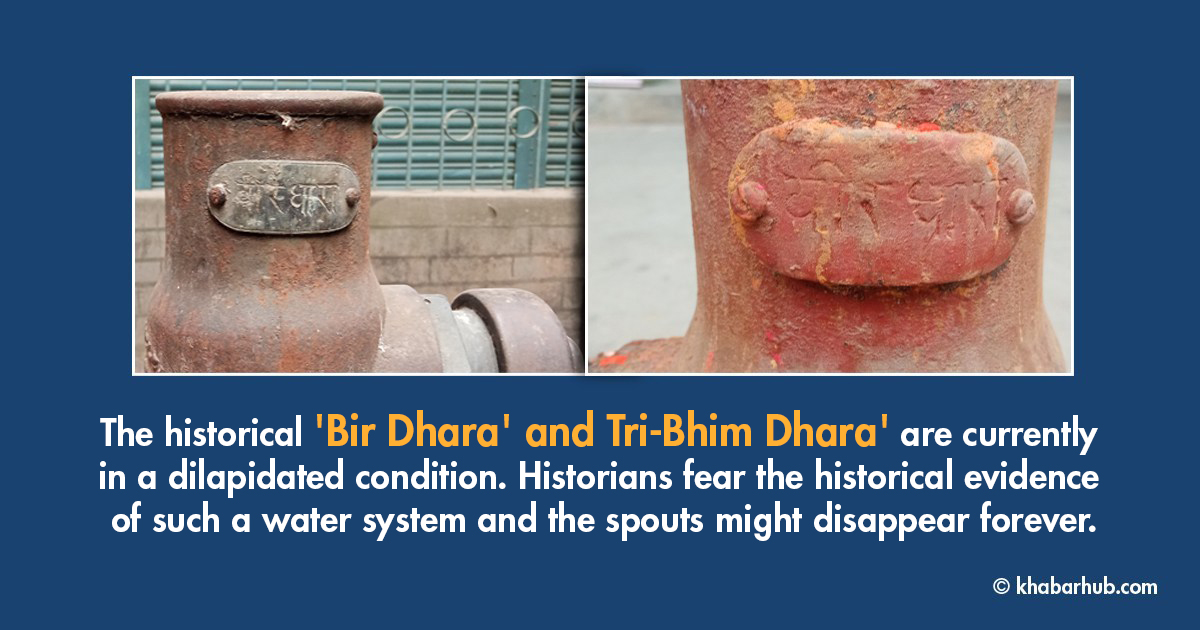KATHMANDU: The remnants of an old spout surrounded by iron bars hold the sight of everyone walking past New Road to Ranjana Street in Kathmandu.
The words ‘Bir Dhara 1890’ is engraved on the upper part of the spout.
This is a residue of a water spout. However, sadly, no water comes from this historic ‘Bir Dhara’.
There is a thick iron pipe about three feet above the ground. One can see the English words ‘ALLEY & MACLLAN 1890, GLASGOW’ written on the spout.
Likewise, one is struck at a similar sight while walking past from New Road Pipalbot to Makhan Street.
On the road belt of Ranjana Street is also an iron pipe lying nearly one foot above the normal water pipe. This old iron pipe also has ‘Bir Dhara’ engraved on it. This part of the pipe is smeared red for worship by the locals.
Likewise, behind the temple of Santaneshwor Mahadev near Indrachowk, there is an iron pipe-shaped structure about four feet above the ground.
There is a round shape at the upper part and the structure below it is broken.
According to historian Ramesh Dhungel, Rana Prime Minister Bir Shumsher made the plan for systematic water supply to the valley in 1888. Accordingly, the construction started from 1889 onwards.
One can see the words ‘Tri-Bhim Dhara 1988’ engraved on the structure. The words show that the spouts were built during the Rana regime. The number 1988 refers to 1932 AD here.
The area around is used for motorcycle parking these days.
Another iron structure appears just below the Dillibazaar Pipalbot. Just below the road there, there is also a broken section of the spout similar to the one behind the Santaneshwor Mahadev Temple. One can see a spout added to the structure.
The only thing that tells this is a spout built during the Rana period is the inscription ‘Tri-Bhim Dhara 1988’. The area is stone-paved, yet it is in dilapidated condition.
Kathmandu Upatyaka Khanepani Limited (KUKL) has managed to supply water through this spout at least once a week. KUKL has, however, used a new pipeline to supply water through the spout.
Rana Prime Minister Bir Shumsher had got these structures constructed to ensure the Kathmanduites get enough drinking water.
Historian Prakash Raj Pandey speculates that the Bir Dhara and ‘ALLEY & MACLLAN 1890 GLASGOW’ carved on the spouts at Ranjana Street suggest they could have been made in the UK. The letters in English support his logic.
A big pond was constructed at Maharajgunj to be used as a reservoir from where the water can be supplied to various areas through the iron pipes. The pond is still called Pani Pokhari. Some more pipes were used to bring water from Shivpuri to the pond. These pipes were relatively bigger.
Bhim Shumsher, who came to power 44 years after Bir Shumsher, got some more water spouts constructed. The spouts built during his time have ‘Tri-Bhim’ carved on them.
Although how many ‘Bir Dhara’ and ‘Tri-Bhim Dhara’ were built in the valley and on which places are still not clear, the remnants show that the trend of constructing spouts for the people started during Bir Shumsher’s time and was continued during Bhim Shumsher’s time as well.
Raju Prajapati, a resident of Ward no. 20 of Kathmandu Metropolis regrets that such taps constructed during the Rana regime are disappearing with the advent of modernity.
He opines that more efforts should be made to conserve these historical structures as they are part of history.
Narayan Karna, the head of KUKL’s Baneshwor Branch, says that they have connected the water pipes to the old spouts to conserve historical water spouts.
But, the only spout to get revived through the efforts is ‘Tri-Bhim Dhara’ of Dilli Bazaar.
The History of Spouts
Although the history of water stone spouts of the valley is said to go past 550 CE, the iron pipes and the spouts connected to them started in 1888.
According to historian Ramesh Dhungel, Rana Prime Minister Bir Shumsher made the plan for systematic water supply to the valley in 1888. Accordingly, the construction started from 1889 onwards.
Bir Shumsher had expanded the pipeline by consulting British engineers in India. After the construction of the spouts, a copper plate each with the inscription ‘Bir Dhara’ was attached to them. Thus, the spouts got the name ‘Bir Dhara.’
According to historian Satya Mohan Joshi, the water brought from Budhanilkantha at the foot of Shivpuri was poured into a pond (near the current Japanese Embassy) and distributed to the Kathmandu people.
Historian Prakash Raj Pandey speculates that the Bir Dhara and ‘ALLEY & MACLLAN 1890 GLASGOW’ carved on the spouts at Ranjana Street suggest they could have been made in the UK. The letters in English support his logic.
Pandey remembers that there used to be water in Bir Dhara till 1975.
“I remember that the inhabitant of Naumug Tol, Indrachowk used the water of Bir Dhara for drinking, cooking, washing and other purposes,” Pandey told Khabarhub and added, “The unsystematic urbanization has resulted in the drying of the spouts as the construction disturbed the water system and its structure.”
He added that Bhim Shumsher unplugged some Bir Dharas and substituted them with Tri-Bhim Dhara.
According to historian Satya Mohan Joshi, the water brought from Budhanilkantha at the foot of Shivpuri was poured into a pond (near the current Japanese Embassy) and distributed to the Kathmandu people.
The ‘Rana Shasanko Britanta’, written by Pramod Shumsher Rana also hails that the water brought to Kathmandu from the foothills of Shivpuri was collected in a big pond in Kathmandu and later distributed to the various parts of the towns through big iron pipes.









Comment